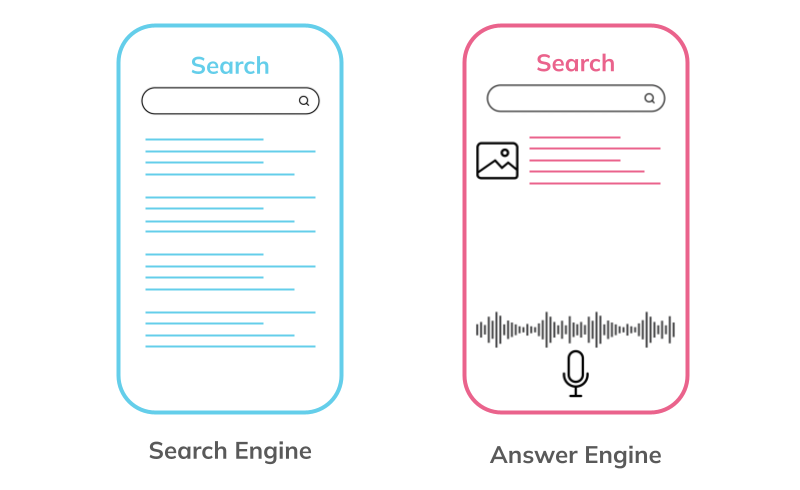Optimizing for Answer Engines: A Step-by-Step Approach
 Hemant SEO
Hemant SEOIn today’s digital world, search engines are no longer just about showing users a list of links. Instead, they have evolved to provide direct answers to the questions people are asking. Answer engines, like Google’s featured snippets or voice assistants such as Siri and Alexa, have become a key part of how we interact with the web.
As a result, businesses and content creators need to understand how to optimize their websites and content to appear in these answer engines.
In this guide, we’ll walk through a step-by-step approach to optimizing your content for answer engines. By following these steps, you can improve your chances of having your content featured as a direct answer, increasing visibility and driving more traffic to your site.

What Are Answer Engines?
Answer engines are tools that aim to provide users with quick, relevant answers to their questions directly on the search results page. Instead of clicking through several links, users can get immediate answers right at the top of the page. Some common types of answer engines include:
Featured Snippets: These are boxes that appear at the top of search results, directly answering a user's question.
Knowledge Panels: These provide quick facts, often about people, places, or things, without needing to click on a website.
Direct Answers: Sometimes, search engines will show a simple, direct answer right under the search bar.
Voice Search Results: With the rise of voice assistants like Alexa and Google Assistant, voice search has also become a form of answer engine.
For example, if you search "What’s the capital of France?" in Google, the featured snippet will likely show "Paris," without you needing to click on any result.
Why Is Optimizing for Answer Engines Important?
The need to optimize for answer engines is growing as more users look for immediate, concise answers. People are turning to these engines for faster, hands-free, and more efficient ways of accessing information. Whether you’re a business or a content creator, appearing in answer engines can significantly increase your visibility and help you reach more people.
For businesses, appearing in answer engines means more than just more traffic—it can lead to higher conversion rates, improved brand authority, and better customer engagement. The quicker you can answer your audience’s questions, the better your chances of establishing trust and gaining new customers.
Understanding How Answer Engines Work
Before diving into optimization strategies, it’s important to understand how answer engines function. The more you know about how they work, the better you can optimize your content to fit their needs.
How Search Engine Algorithms Rank Content
Search engines use complex algorithms to decide what content to display in response to a user's query. These algorithms look at several factors, such as relevance, content quality, and user intent.
For example, Google uses its RankBrain algorithm to process queries and deliver the best possible answers. It looks at the context of the query, user behavior, and other signals to determine which content is most likely to answer the question.
Key Features of Answer Engines

Answer engines rely on certain features to deliver information efficiently:
Featured Snippets: These are boxes that appear above organic search results. They are designed to show a summary of the best answer to a user’s query.
Knowledge Panels: These provide a snapshot of factual information, such as quick facts about a famous person or place.
Direct Answers: Sometimes, answer engines provide a simple, brief answer under the search box.
Voice Search Results: Voice assistants like Siri, Google Assistant, and Alexa give direct answers in a conversational tone.
Understanding these features can help you structure your content to meet the specific needs of each one.
Types of Queries Answer Engines Target
Answer engines are most commonly used to answer informational queries, such as:
"What is the capital of Japan?"
"How to bake a chocolate cake?"
"What are the benefits of yoga?"
These are direct questions where users expect to receive quick answers. Answer engines are designed to provide that instant information without requiring the user to click through to a website.
Step 1: Identify Common Questions in Your Niche
To optimize for answer engines, the first step is to understand what questions your audience is asking. Once you know what information they’re looking for, you can tailor your content to address those queries directly.
Research User Intent
User intent refers to the reason behind a search. Are they looking for information, trying to make a purchase, or looking for a solution to a problem? Understanding user intent is critical because it helps you provide the most relevant answer.
Informational Intent: The user is looking for answers or information. For example, "What is SEO?"
Transactional Intent: The user is looking to make a purchase or take a specific action. For example, "Buy running shoes."
Navigational Intent: The user is trying to find a specific website. For example, "Facebook login page."
You can use tools like Google Keyword Planner, AnswerThePublic, or Ubersuggest to find questions people are asking in your niche.
Analyze SERP Results
Once you’ve identified the questions your audience is asking, it’s time to analyze the search engine results page (SERP) to see how your competitors are answering these queries. This will help you understand how you can create better content.
Search for a few common questions in your industry. Look for:
Featured snippets
Knowledge panels
People also ask (PAA) boxes
Top-ranking articles
If your competitors are ranking well, you can learn from their content structure and find opportunities to do better.
Create a List of Target Questions
Create a list of the most common questions in your niche. Focus on those that are:
Frequently asked by your target audience.
Likely to appear in answer engines.
Relevant to your products, services, or content.
By answering these questions directly in your content, you increase your chances of ranking in answer engines.
Step 2: Structure Your Content for Answer Engines
Once you’ve identified the key questions to target, the next step is to structure your content so it’s optimized for answer engines.
Focus on Concise, Direct Answers
Answer engines are designed to give users quick answers, so it’s important to keep your answers brief and to the point. A general rule of thumb is that the best answers are between 40-50 words.
For example, instead of writing a long, detailed paragraph, try summarizing your answer in one or two clear, concise sentences. Keep it simple!
Use Structured Data Markup (Schema.org)
Structured data helps search engines understand the context of your content. By adding schema markup (a type of structured data) to your content, you can provide search engines with specific details about your content. This makes it easier for them to understand and display your content in answer engines.
For example, if you have a recipe blog, you can use schema markup to indicate ingredients, preparation time, and nutritional information. This helps answer engines show your recipe directly in search results.
Format for Featured Snippets
To increase your chances of appearing in featured snippets, structure your content in a way that makes it easy for search engines to extract information. Some common formats include:
Lists and Bullet Points: Answer engine snippets often display lists of steps or key points.
Tables: If you’re presenting data, a well-organized table is easy for search engines to interpret.
Headers and Subheaders: Break your content into clear sections with descriptive headings.
Optimize for Voice Search
With the rise of voice assistants, it’s essential to optimize for voice search. Voice search queries tend to be longer and more conversational. For example, people may ask, "How do I bake a chocolate cake?" rather than just "bake chocolate cake."
To optimize for voice search:
Use natural language and answer in a conversational tone.
Use question-based headlines (e.g., "How to make homemade pizza?")
Keep your answers clear and simple.
Step 3: Create High-Quality, Authoritative Content
Answer engines prioritize authoritative content, so your content must be trustworthy and reliable.
Provide In-Depth and Reliable Information
Answer engines look for content that is comprehensive and authoritative. Make sure your answers are well-researched, accurate, and thorough. Always back up your claims with credible sources, such as studies, expert opinions, or reliable data.
Align with User Search Intent
Your content should always address the user’s intent. This means if someone is asking a question about a product, your content should focus on giving them the most helpful answer, not just promoting your product. Always prioritize the needs of the user over your sales goals.
Keep Content Updated
Answer engines prefer fresh, relevant content. Regularly update your content to keep it accurate and in line with current trends and data. This shows search engines that your content is up-to-date and useful to users.
Step 4: Enhance User Experience (UX)
A good user experience (UX) helps increase the chances of your content ranking in answer engines. If users have a positive experience, they are more likely to stay on your page longer, engage with your content, and share it.
Page Load Speed and Mobile Optimization
Page speed and mobile optimization are critical ranking factors for answer engines. If your site takes too long to load or doesn’t work well on mobile devices, users may leave before they even see your content.
Use tools like Google PageSpeed Insights to test and improve your website's speed. Additionally, ensure your website is fully responsive, meaning it adapts well to any screen size.
Readability and Accessibility
Answer engines favor content that is easy to read and understand. Use clear, simple language and break up your content with short paragraphs, bullet points, and headers. Make sure your content is also accessible to everyone, including those with disabilities, by using alt text for images and ensuring good contrast between text and background.
Interactive Content
Interactive content, such as quizzes, calculators, or videos, can keep users engaged longer and help improve your chances of ranking in answer engines. The more time users spend on your page, the more likely search engines will consider your content valuable.
Step 5: Monitor and Adjust Your Strategy
Once you’ve implemented these optimizations, it’s important to track how well your content is performing and make adjustments based on data.
Track Featured Snippets and Answer Engine Results
Use tools like Google Search Console, SEMrush, or Ahrefs to track how your content is performing in search engines. Monitor if your content appears in featured snippets or other answer engine formats.
Analyze Performance Metrics
Look at important performance metrics such as:
Click-through rates (CTR)
Bounce rates
Conversion rates
By analyzing these metrics, you can see which content is performing well and which needs further optimization.
Iterate Based on Data
Content optimization is an ongoing process. Based on the data you collect, adjust your content to improve its performance. This might mean rewriting sections for clarity, adding more details, or focusing on different keywords.
Best Practices and Common Pitfalls to Avoid
Best Practices
Always focus on user intent.
Use clear, concise language.
Regularly update your content.
Optimize for mobile and page speed.
Common Pitfalls
Over-optimization: Don't overstuff your content with keywords. Focus on quality.
Ignoring mobile optimization: More people are using mobile devices, so your site must work well on them.
Neglecting schema markup: Structured data is essential for helping search engines understand your content.
Conclusion
Optimizing for answer engines is an essential strategy for improving your visibility in today’s search landscape. By focusing on providing clear, concise answers, using structured data, and ensuring your content is authoritative, you can increase your chances of ranking in featured snippets, knowledge panels, and other answer engine results.
Remember, the key to success is not just about ranking higher; it's about answering your audience's questions effectively and providing them with value. Start implementing these strategies today, and watch your content soar to the top of search results.
Subscribe to my newsletter
Read articles from Hemant SEO directly inside your inbox. Subscribe to the newsletter, and don't miss out.
Written by
